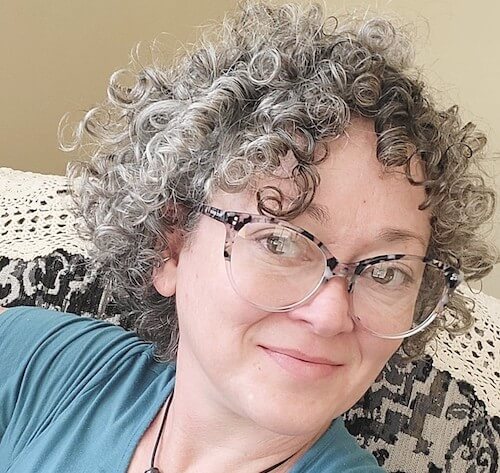Lately your hair has been looking a little worse for wear. But what is causing all that hair damage? Is there a solution for how to fix damaged hair?
Today we'll outline some strategies for healing hair that has seen tough times. Keep reading to learn tips and tricks to repair hair and prevent further damage. Plus, learn about what you should be using to support well-nourished and healthy hair.
#include-related-slider#
What Causes Damaged Hair?
To get your head around the concept of hair damage, it helps to understand the structure and composition of hair. The hair shaft—the part of hair that we can see—is composed of dead "keratinized" cells. During the process of "keratinization," cells transform into keratin, a specialized protein produced by the body.
Thus, the cortex—the main layer of your hair—is composed of keratin protein molecules. (The shape of the cortex also determines your hair's texture!) However, harsh procedures such as chemical treatments or heat tools can degrade the keratin in the cortex, creating damage to the hair's internal structure.
The cuticle—the outermost layer of your hair—is also made of keratin, but it is thinner than the cortex and colorless. Under a microscope, it looks similar to fish scales or roof shingles. The cuticle's purpose is to offer a sheath of protection for the inner fibers of the hair, but when it becomes lifted or ruffled, it can gives the hair a frizzy appearance.
If the keratinous structures of hair are damaged, they can be fortified for more strength but not completely repaired. Luckily, hair technologies and products do exist to reinforce the hair shaft.
Read More: What Is Hair Made Of?
Symptoms of Damage
It can sometimes be hard to tell if you're dealing with damaged hair or just dry hair that needs moisture. Coarse hair can also feel rough or look frizzy, making you think it could be damaged. Brittle hair, dry hair and frizzy hair can all be a result of damage—but how can you tell if your hair is damaged without viewing its structure under a microscope? Read on to learn which signs can be indicators of damaged hair.
Do You Have Damaged Hair?
Use this list to analyze your hair's integrity and to look for signs of damage. You may have damaged hair if:
- Hair becomes wet easily, and once wet, it feels mushy, stretchy, limp or gummy. It dries quickly but then becomes frizzy. Hair that has lost its structural integrity lacks elasticity and has "holes" in its structure, making it absorb water too quickly and easily. This gives hair that "mushy," soggy feeling.
- Hair has some areas that feel "fuzzy," dry or brittle to the touch.
- Hair splits at the ends or vertically up the shaft from the ends. This can sometimes be due to stress on the hair from styling.
- Hair has layers of treatment, including hair coloring and/or other chemical procedures. Poorly overlapped treatments can create weaker spots on the hair shafts that could lead to hair breakage.
- Hair strands have whitish areas, usually toward the end of the hair shaft, or have split ends.
- Hair feels rougher and more dried out than usual after a season of heavy heat styling or a chemical treatment.
- You can tell for any other reason that your hair needs help.
When hair is healthy, it is pliable, free of knotted areas or split ends and should not pull or snap when you comb it with a wide tooth comb. Even dyed hair, dry hair, naturally frizzy or coarse-feeling hair can be healthy—it just may need a little extra moisture. When your hair needs that extra care, address the issue sooner rather than later to help you to avoid long-term (and sometimes irreparable) damage.
Shop: The Wrap & Revive Kit for Damaged Hair
How to Fix Damaged Hair
Fixing damaged hair is never a simple one-and-done. Luckily, though, there are several things you can do to nourish your hair follicles, provide moisture, incorporate reparative care and prevent further damage. In more severe cases, extremely damaged hair may need to be trimmed away to allow for new growth.
Restoring healthy hair involves:
- Adjusting your hair care routine to nourish your hair and prevent further damage
- Making improvements to your nutritional intake, diet and overall health and wellness
- Getting regular haircuts to trim away hair with breakage or other damage
- Using a regular deep conditioning treatment with strengthening proteins to target areas of damage and fortify hair
Learn: Is It Bad to Wash Your Hair Daily?
Step 1: Avoid Further Damage to Hair
On your journey to healthier hair, the first and foremost course of action is to stop doing things that may lead to further damage to your hair. You should:
Avoid Heat Styling
When repairing damaged hair, it's essential to avoid heat damage on hair that is in weak condition. Harsh heat styling can further stress the hair, resulting in hair loss due to hair breakage.
- Use heat styling sparingly, if at all. Turn the heat on your hair dryer down to the lowest setting, and ditch your flat iron and curling iron. If you need to use a blow dryer or other heat tools, make sure to use a heat protectant.
- Use a heat protection product to help create a shield around your hair. This helps you avoid excessive heat from blow dryers, curling irons and flat irons. While this can help protect hair to an extent, it's best to abstain from heat styling altogether when working to improve damaged hair.
Use Gentle Hairstyles
You may not usually think about how a hairstyle might affect your hair, but certain types of hair styling can damage your hair.
- Avoid choosing tight hairstyles, which can create stress and breakage on the hair.
- Don't brush through your hair when it's wet, since brushing wet hair can lead to breakage and further knotting (use a wide-tooth comb on wet hair).
Shop: Hair Repair Products
Be Careful With Hair Treatments on Damaged Hair
Hair color and other chemical treatments (such as hair straightening) can degrade the natural keratin proteins in the hair, creating weak spots that lead to breakage. It can be hard to wait, but while you are in the process of repairing your hair, avoid hair color, chemical dyes or chemical treatments—hold off until your hair is well enough to endure it.
Step 2: Nourish Your Hair, Nourish Your Body
Issues with hair growth, hair loss or any sort of hair damage can sometimes be indicative of a nutritional deficiency or other health issue. To keep your hair nourished at the hair follicle (the "root" of the hair):
- Make sure you're eating a well balanced diet rich in vitamins, essential fatty acids, Omega-3s, and lean protein. Consider incorporating a biotin supplement.
- See your doctor to rule out any underlying illnesses that could be contributing to hair loss, a sudden onset of brittle hair or other hair damage that you can't explain.
Learn More: What Causes Hair Loss? Every Trigger Explained
Step 3: Eliminate Split Ends
Split ends are a common culprit of hair damage and hair loss since they can spread vertically up the hair shaft, creating additional damage. A common misconception is that you can "undo" split ends. While this isn't the case, there are things you can do to prevent them from spreading.
- See a hairstylist regularly to trim away existing dead and split ends, especially if you're trying to grow out damaged hair.
- Use a deep conditioning treatment to add extra moisture to soothe your hair.
Further Reading: Do Split Ends Stop Hair Growth?
Step 4: Use Deep Conditioning Treatments
Once the integrity of the hair structure has been broken down or "fractured"—scientists refer to it as "cuticle-cortex separation"—the hair shaft cannot be put back together or otherwise repaired to its former healthy state. With that said, you can incorporate moisture and protein to improve the appearance of hair and help protect from additional damage.
VEGAMOUR spoke with Dr. Cheryl Rosen, Director of Dermatology at BowTied Life, to clear up the confusion what keratin and other proteins do for hair.
"Keratin products work by filling in the damaged areas of the hair with keratin protein," Dr. Rosen explained. "This makes the hair stronger and helps to prevent further damage."
This means that a damaged hair cuticle can be smoothed down and improved but not completely repaired. The broken molecules of the hair — that is, the hair's naturally occurring keratin proteins — cannot be repaired.
You can, however, add moisture and smoothing agents to your hair to improve its appearance and to protect it from additional damage. Many products currently on the market, however, use synthetic or animal keratin proteins, which are larger molecules that do not effectively penetrate the hair.
VEGAMOUR tackles this hair health conundrum head-on with a high-moisture deep conditioning mask that uses Karmatin™, a proprietary microencapsulated b-silk™ protein that is plant-based, smaller, and best of all, vegan-friendly. Karmatin is made with protein that mimics the natural protein found in hair and bonds with damaged hair to smooth it out for an improved appearance and—most importantly—protection. Karmatin™ is featured in VEGAMOUR shampoos, conditioners and masks. Shop all Karmatin™ products here!
Shop: GRO+ Advanced Essentials Kit
Use a Deep Conditioning Hair Mask
Hair masks are designed to treat damaged hair, restore the moisture lost from hair's natural oils and to help to smooth out the cuticle of the hair. For best results, use a hydrating hair mask at least once a week. goes a step further.
This mask from VEGAMOUR isn't your standard deep conditioner — it supplies intuitive technology, powered by Karmatin™ to help reduce frizz, enhance color and shine and helping to improve your hair's appearance for a healthy, nourished look.
Karmatin™ also adds a layer of protection for color-treated and damaged hair, leaving it feeling stronger and more hydrated. It packs the surface of the hair cuticle with a microencapsulated version of a plant-based protein, called b-SILK™, that is molecularly similar to your hair's naturally occurring keratin. Plus, it is formulated without sulfates, phthalates or silicones. It's the first "smart" mask designed to adapt to the unique needs of damaged hair.
#include-related-slider#
Deep Condition Your Way to Healthy Hair
While you can't magically snap your fingers and make years of hair damage disappear, taking the first steps is easier than you might think. There are plenty of accessible ways to protect and soothe damaged hair—not to mention ways to avoid future damage—so your strands look and feel better. VEGAMOUR's deep conditioner treatment is easy to use — just massage it in and leave overnight (or for 10 hours), rinse out and enjoy your refreshed hair.
You can learn more ways to protect your hair and keep it healthy by staying up to date with the VEGAMOUR blog. And check out the other healthy-hair products designed to suit your hair type's unique needs so you can ensure your mane is nourished and protected.
More From VEGAMOUR
- Shop: VEGAMOUR Conditioners
- Why Choose GRO Hair Serum
- How to Tame Frizzy Hair
- How to Prepare Your Hair for Bleaching
- How Long Does It Take for Hair to Grow?




















